Volkswagen Multivan Review 2025: Price, specs & boot space
Written by Andrew Brady
Quick overview
Pros
- Versatile in a way that no SUV can match
- Easier to drive and more comfortable than van-based rivals
- Loaded with clever safety systems
Cons
- It's not cheap
- Your kids will never want to be driven in a normal car again
Verdict: Is the Volkswagen Multivan a good van?
"Whether you're looking for the ultimate family transport, need to transport Lord Sugar to the golf club or just want a car that doubles up as a work van, the Volkswagen Multivan is one of the most versatile people carriers on sale today."
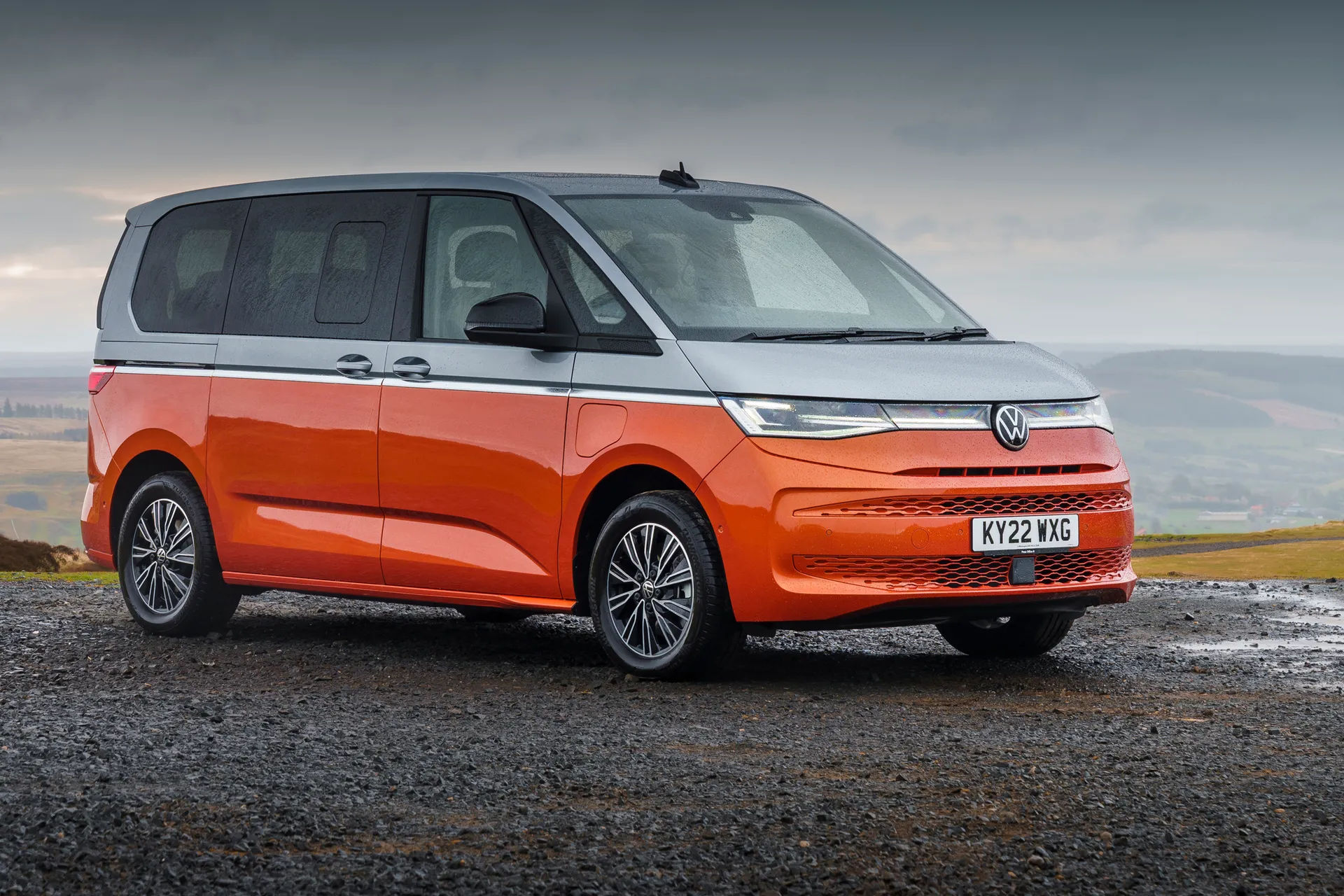
The Volkswagen Multivan is a replacement for the old Volkswagen Caravelle and rivals van-based people carriers like the Ford Tourneo Custom, Mercedes V-Class and Citroen SpaceTourer. But it has an ace up its sleeve.
Unlike its slightly utilitarian rivals, the new Volkswagen Multivan is actually based on a car platform. That means it's better to drive and features all the latest safety technology, while it should also be fairly cheap to run. Continue to read our full Volkswagen Multivan review to find out whether you should be thinking twice about yet another SUV.
There's no denying that the Volkswagen Multivan looks big and square – a bit like a van with windows. It even has 'van' in its name. But underneath is the same platform as a wide range of Volkswagen Group models, including the Volkswagen Tiguan and Skoda Kodiaq.
There are many advantages to this. For a start, it means Volkswagen can offer the Multivan with the same plug-in hybrid system as cars like the Volkswagen Tiguan eHybrid. That's unusual for a people carrier of this size, and its 57-mile electric range means you can drop the kids at school in eco-friendly silence.
The entry-level Life has two engine choices: the 1.5 hybrid and a 2.0-litre diesel. Upgrade to the Style, and buyers can also choose from a 2.0 TSI with 204PS.
With light steering and a relatively tight turning circle, the Volkswagen Multivan isn't going to make your palms sweaty as you thread it down a narrow side street. It's slightly lower than the old Volkswagen Caravelle, too, meaning – in theory – you're less likely to be turned away from multistorey car parks. A 360-degree camera system comes in very handy when squeezing the Multivan into a tight space. Sliding side doors help with loading kids, too.
The Volkswagen Multivan is every bit as spacious as you'd expect from a car that is definitely not a van but is as big as a Transit. It's actually quite clever how configurable the cabin is – you can have up to seven seats, which they be moved about (or removed entirely) at your whim. This means you can even have the rear seats facing each other, if you like, although they don't twizzle around like they used to in the Volkswagen Caravelle.
It's priced from £49,613, meaning it's slightly cheaper than a Ford Tourneo Custom. The range-topping Style costs £61,411. Of course, this will rise depending on option selection.
Looking for a used car for sale? We've got 100s of Volkswagen Approved Used Cars for Sale for you to choose from, including a wide range of VW Multivans for sale. If you're looking for the Multivan's predecessor, you need our Volkswagen Caravelle review.
Is the Volkswagen Multivan right for you?
We reckon the Volkswagen Multivan will appeal to quite a wide audience. You might be a rapidly growing family that needs something more versatile than a Nissan Qashqai, a tradesperson who needs to carry passengers at the weekend, or just a mountain bike enthusiast who doesn't want the faff of a roof rack. Its improved road manners (compared to the Volkswagen Caravelle) mean it's easier than ever to recommend.
What’s the best Volkswagen Multivan model/engine to choose?
The plug-in hybrid makes a lot of sense on paper, but a lot of buyers will find it's not worth the additional outlay. It's thirsty when not fully charged, while the weight of the batteries means it's not as comfortable to drive as other models.
Therefore, we'd recommend the Volkswagen Multivan with the 2.0-litre petrol or diesel engine. Both have enough power for motorway driving, although you'll have to be prepared for fairly high fuel bills. The 2.0-litre TDI is likely to be a good alternative if you cover a lot of motorway miles – or, if you want electric family transport, the Volkswagen ID Buzz.
What other cars are similar to the Volkswagen Multivan?
While the Volkswagen Multivan might be based on a car platform, it rivals a wide range of van-based people carriers. These include the Mercedes-Benz V-Class, Citroen e-SpaceTourer, Peugeot E-Traveller, Toyota Proace Verso EV and Ford Tourneo Custom. There's also the Dacia Jogger and the Skoda Kodiaq.
Comfort and design: Volkswagen Multivan interior
"In keeping with the 'not a van' theme, the Volkswagen Multivan's interior looks very similar to a Volkswagen Golf's, albeit quite a bit bigger. It doesn't feel like a commercial vehicle up front, although you do get big, comfortable seats and an SUV-like driving position."
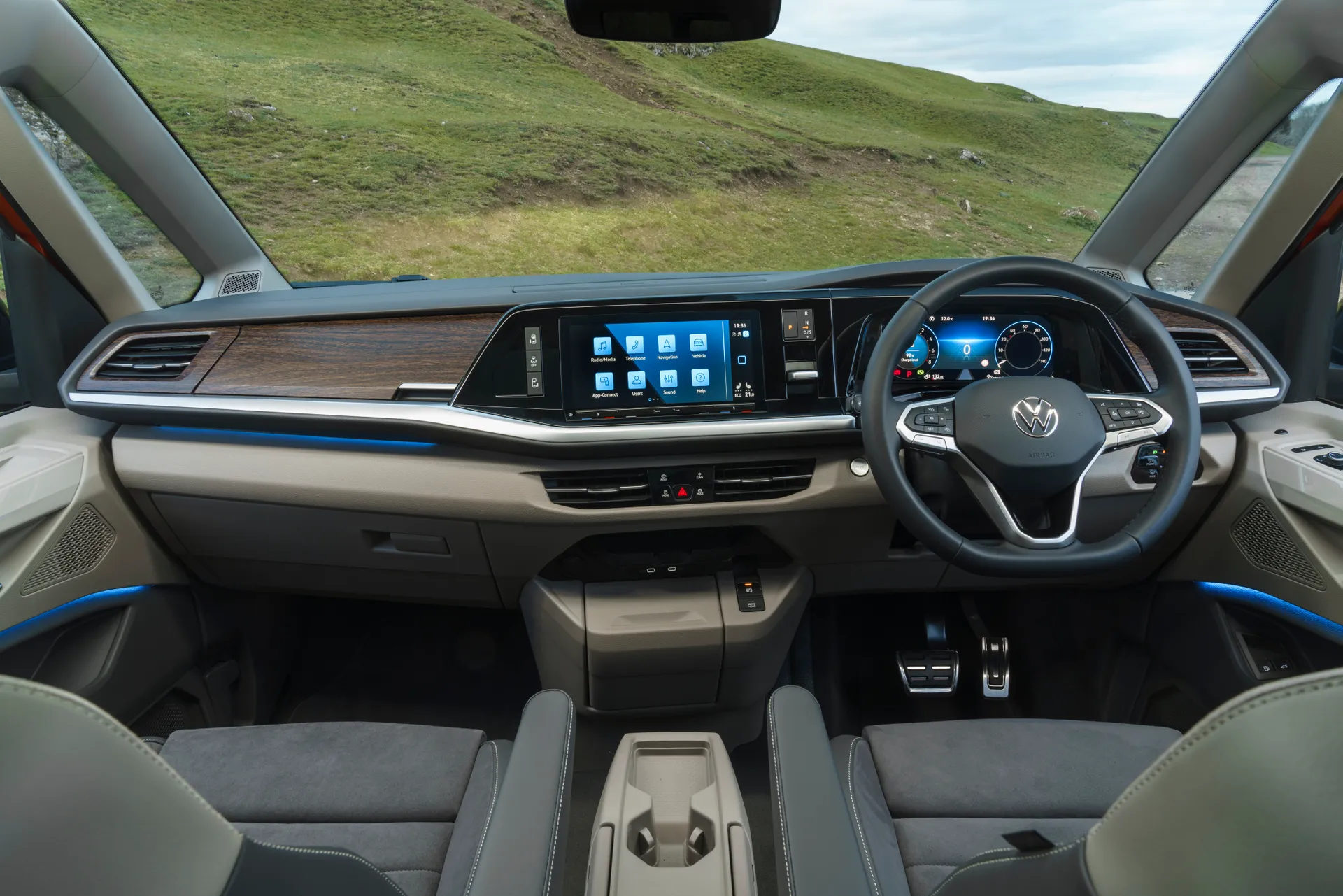
There are many nifty features that make the Multivan an ultra-practical family car. Things like the sliding centre console and changeable seating layout help, while there are a multitude of storage areas to keep your phone, water bottle or general detritus.
With space between the front seats, a completely flat floor and no conventional gear stick to get in the way, you can stand up and walk through to the rear, if you want. That's great when attending to young children or just when you fancy a change of scenery.
It's worth mentioning the Volkswagen Multivan's panoramic sunroof. It's the biggest panoramic sunroof VW makes, apparently (not that surprising, but you never know, it might come up in a pub quiz one day). It does make a big difference to the interior, flooding it with light and even increasing the space on offer, if you actually want to use the Multivan as a van.
Quality and finish
How happy you'll be with the quality and finish of the Volkswagen Multivan's cabin depends largely on your expectations. It certainly looks generally very smart, and we're sure it won't prove too fragile for family life. You can sense the 'however' coming.
There are a few quite harsh plastics that wouldn't look out of place in a van, but if you're considering the Multivan as an alternative to a posh SUV, they appear a little less acceptable. The sliding centre console slash pull-out table is a case in point - it's got more than a touch of Fisher-Price 'My First Kitchen' about it.
Infotainment: Touchscreen, USB, nav and stereo in the Volkswagen Multivan
A 10-inch Digital Cockpit display replaces conventional dials, while a head-up display is also available, providing information like current speed conveniently within the driver's eye line. Further tech highlights include wireless smartphone charging and an eight-speaker sound system. Buyers can add Digital Cockpit Pro, a Harman Kardon sound system, and a navigation system at extra cost.
The Style gets Digital Cockpit Pro and the "Discover Pro" navigation system as standard. All cars get wireless Android Auto and Apple CarPlay to boot.
Space and practicality: Volkswagen Multivan boot space
As you'd expect for something as big and boxy as the Volkswagen Multivan, it's massively practical. Whether the family's outgrown your Touareg or you're looking for the ultimate versatile Uber car, the Volkswagen Multivan is one step down from a minibus when it comes to interior space.
There's enough room for up to seven seats, with those in the rear given the ability to be moved about to cater to your needs. The rear seats can't be swivelled about like in the old Caravelle, but that means they're 25% lighter, making it easier to lift them out and spin them around or leave them in the garage if they're surplus to requirements.
The seats slot into electrified grooves in the floor (that means they can be heated, if you splash the cash on the options list). There's also a trick multi-function table which also slides into the tracks. This can be used as a centre console for those in the front, or a fold-out table complete with cup holders and storage bins for those in the back.
There are two different lengths of Multivan on offer. The standard car has a very usable 469-litre boot space behind the third row of seats, extending to up to 1844 litres behind the second row. Remove the rear seats entirely, and it can swallow a van-like 3672 litres of luggage. Buy one with the panoramic sunroof and extra room in the roof means it can carry 3710 litres.
The Volkswagen Multivan measures 1941mm wide, 4973mm long and up to 1909mm high. It’s that latter figure that’s perhaps the most significant – it’s marginally lower than the Volkswagen Caravelle, which might be just enough to help you squeeze into a multi-storey car park.
It has a wheelbase of 3124mm, while there’s also a longer model available with an extra 20cm of rear overhang (taking the total length to 5173mm). Depending on which engine you choose, the Volkswagen Multivan has a towing capacity of up to 2000kg.
Handling and ride quality: What is the Volkswagen Multivan like to drive?
"As we've touched on, the Volkswagen Multivan is now based on a car platform – the same one which underpins a wide range of cars from the Volkswagen Polo to the Skoda Kodiaq. While that doesn’t mean it’s as lithe and agile as an Audi TT, it does mean it feels surprisingly car-like to drive around town, thanks to a tight turning circle and extremely light steering."
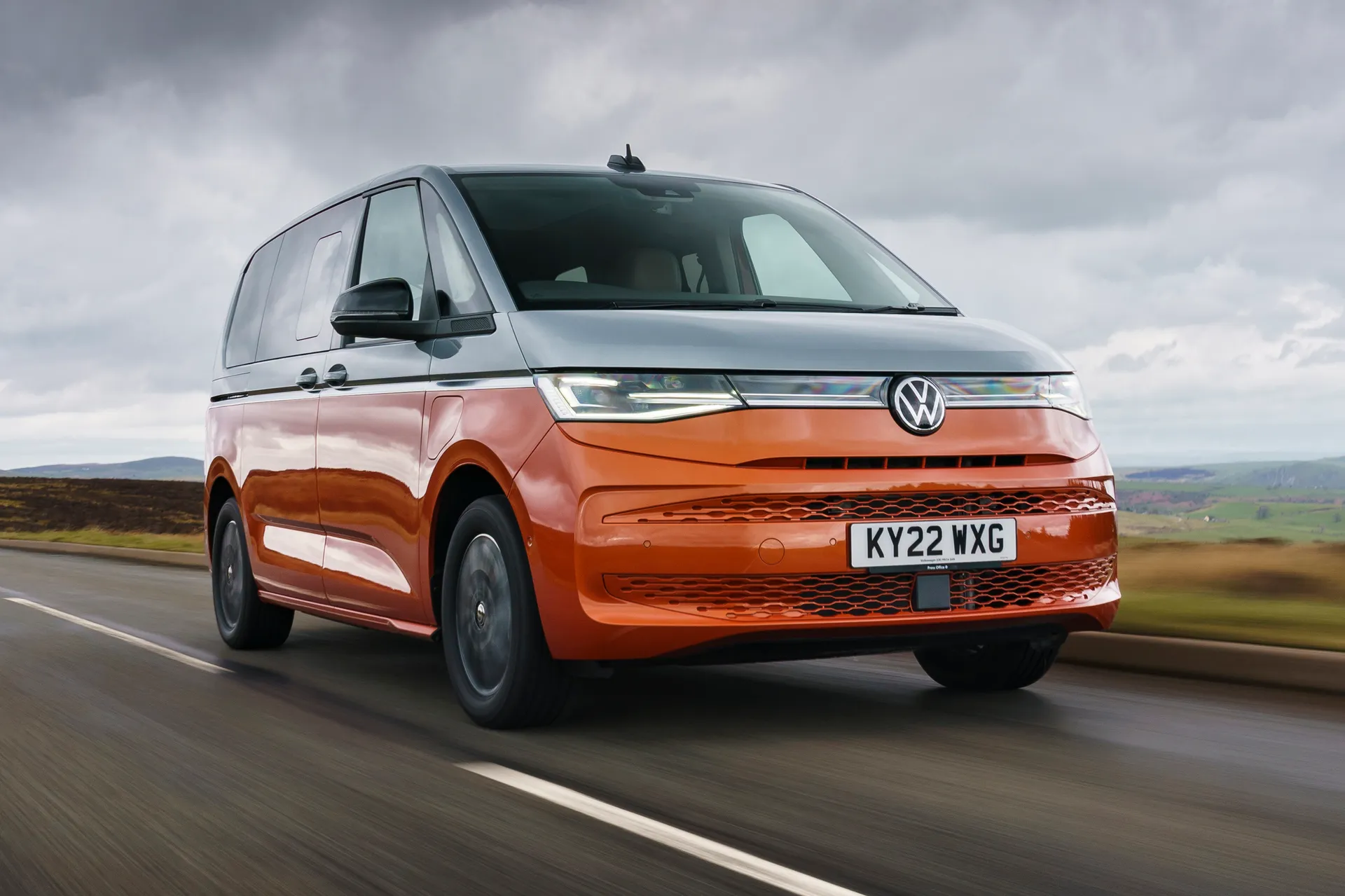
It might look more like a van than conventional people carriers like the SEAT Alhambra, but the Volkswagen Multivan feels easy to drive, helped by a huge windscreen and excellent forward visibility. The brand's Area View feature is a very useful tool, too, using four cameras to provide a 360-degree image on the Multivan's infotainment screen.
While we can't deny that the Volkswagen Multivan feels rather large around town, it's certainly one of the less intimidating people carriers of this size to drive. On the open road, meanwhile, it handles perfectly well, although the extraordinarily light steering might take a bit of getting used to. It'll roll about a bit during cornering, too, but ultimately it feels pretty unflappable.
One area in which the Volkswagen Multivan is a bit more van-like is the ride quality. It clatters over uneven road surfaces, while the plug-in hybrid model in particular feels rather heavy. You can hear the suspension working away to cope with the weight of the batteries, but that’s a price you’ll have to pay for economy.
What engines and gearboxes are available in the Volkswagen Multivan?
The big news, in engine terms, is the addition of the plug-in hybrid model. Badged the Volkswagen Multivan eHybrid, the PHEV variant uses a 1.5-litre petrol engine combined with a 19.7 kWh battery and 85kW electric motor.
Skip down to the efficiency section to find out how economical it is, but it produces a combined 245PS. The potent power is offset to some degree by the Multivan's weight (in PHEV form, it weighs up to 2391kg with a driver) – still, it'll lumber to 62mph in 9.4 seconds, a slight increase over the 204PS' 11.6 seconds.
Entry-level cars are offered with the previously mentioned hybrid and a 150PS 2.0-litre TDI, while Style buyers can choose a 204PS 2.0 TSI. All engines are DSG only and range between six and seven speeds.
Refinement and noise levels
Refinement is generally very good, although the Volkswagen Multivan's blocky dimensions mean there is a fair bit of wind noise at motorway speeds.
Safety equipment: How safe is the Volkswagen Multivan?
The Volkswagen Multivan was tested by EuroNCAP in 2022 and received a five-star safety rating. Drilling down, it also received a 90% adult occupancy rating, an 89% child rating, and scored 87% in safety assist.
It also comes packed with safety tech to boot, like autonomous braking, LED headlights, lane change assist, lane keep assist, a rear-view camera, side and curtain airbags, and eCall Emergency System.
MPG and fuel costs: What does a Volkswagen Multivan cost to run?
"The Volkswagen Multivan returns up to 353mpg in hybrid form."
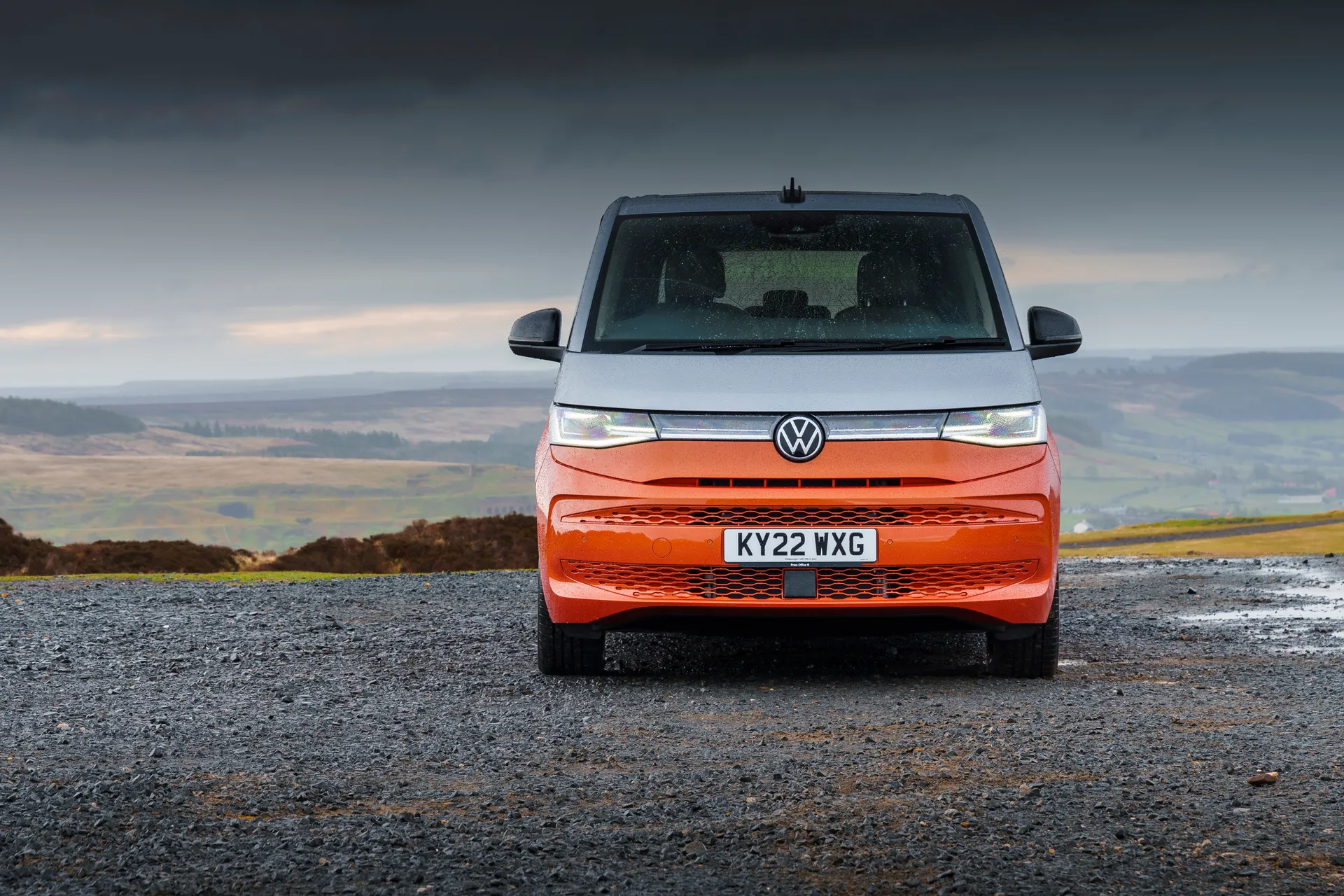
When fully charged, the Multivan runs up to 57 miles solely on electric power. Standard overhand vans are claimed to return 353.1mpg, while long Multivans return 313.9mpg. The diesels return 43.5mpg regardless of overhang, while the TSI returns the worst at 31.7mpg.
Volkswagen Multivan reliability and warranty
The Volkswagen Multivan is still a very new model, so we’re yet to find out how reliable it’ll be in the long term. Its predecessor, the Volkswagen Caravelle, proved to be a very dependable choice, though, and we doubt the Multivan will be any different.
Its engines are used in a wide range of Volkswagen Group models, many of which have ranked highly in the annual HonestJohn.co.uk Satisfaction Index.
Volkswagen was 17th out of 33 manufacturers in the latest HonestJohn satisfaction index. Volkswagen also offers a three-year/60,000-mile warranty with its cars.
Volkswagen Multivan insurance groups and costs
Insurance groups start at 23 for earlier 1.5 TSI Life cars. The newer 1.5 hybrids are Group 35 and stretch to 38 for Style models. 2.0-litre diesels start at Group 26 while 2.0-litre TSI cars are Groups 36 and 37.
VED car tax: What is the annual road tax on a Volkswagen Multivan?
All Multivan models cost £40,000-plus, meaning expensive car tax applies. First-year savings are possible if you opt for the right van. 1.5 hybrids cost £110 in showroom tax and default to £620 per year. Steer clear of TSI Style models unless you're happy to pay £3,300 in showroom tax, followed by £620 per year thereafter.
2.0-litre diesels fetch from £1,360 to £2,190 in showroom tax, depending on the selected model, before defaulting to £620 per year.
Volkswagen Multivan price
"The Volkswagen Multivan range starts from around £49,000 for an entry-level Life model, while the top Style van is priced from £61,400"
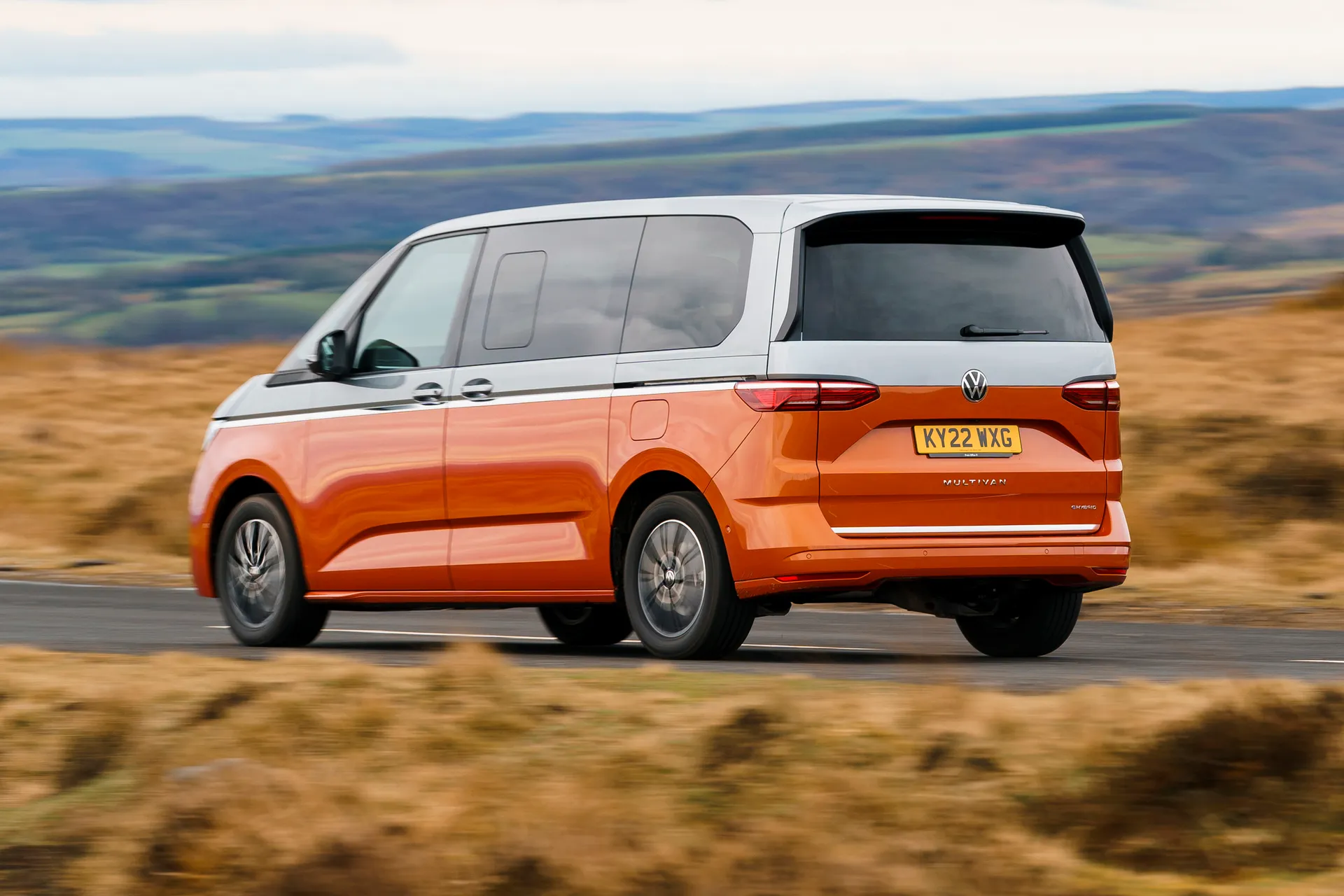
£49,613 gets you the standard diesel, while the long overhang costs £1,458 extra. Hybrid vans are priced from £54,525, while TSI cars (Style only) start at £65,467.
Used Multivans fetch from £36,000. This gets you a 1.5 TSI Life (a previously offered engine) with 30,000 miles. Used 2.0TDI vans are priced from £42,000 with under 30,000 miles, while hybrids demand upwards of £45,400.
Trim levels and standard equipment
Specification on the entry-level Volkswagen Multivan Life includes 16-inch alloy wheels, seven seats, two sliding doors with power latching and a 10-inch infotainment system.
The Volkswagen Multivan Style introduces the IQ.LIGHT LED matrix headlights, the Discover Media navigation system, Park Assist, electric sliding doors and a tailgate with the easy-open feature, and 17-inch alloys.
Ask the heycar experts: common questions
How much is a Volkswagen Multivan?
What are the alternatives to a Volkswagen Multivan?
What's the difference between a Volkswagen Multivan and Caravelle?
Get our latest advice, news and offers
Keep me updated by email with the latest advice, news and offers from heycar.
By submitting you agree to our privacy policy



